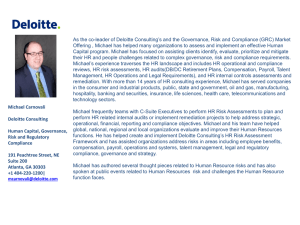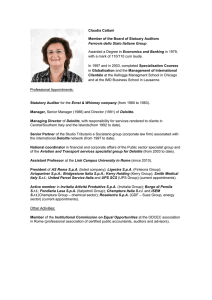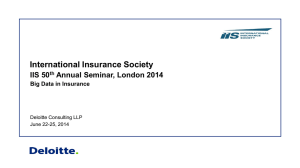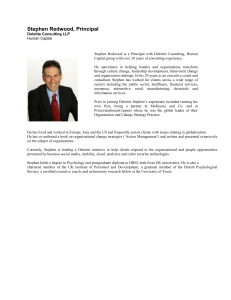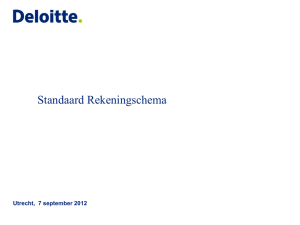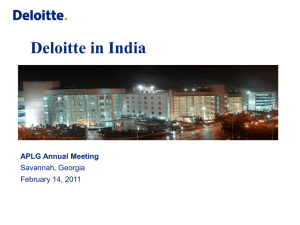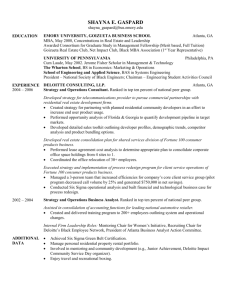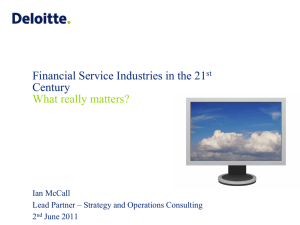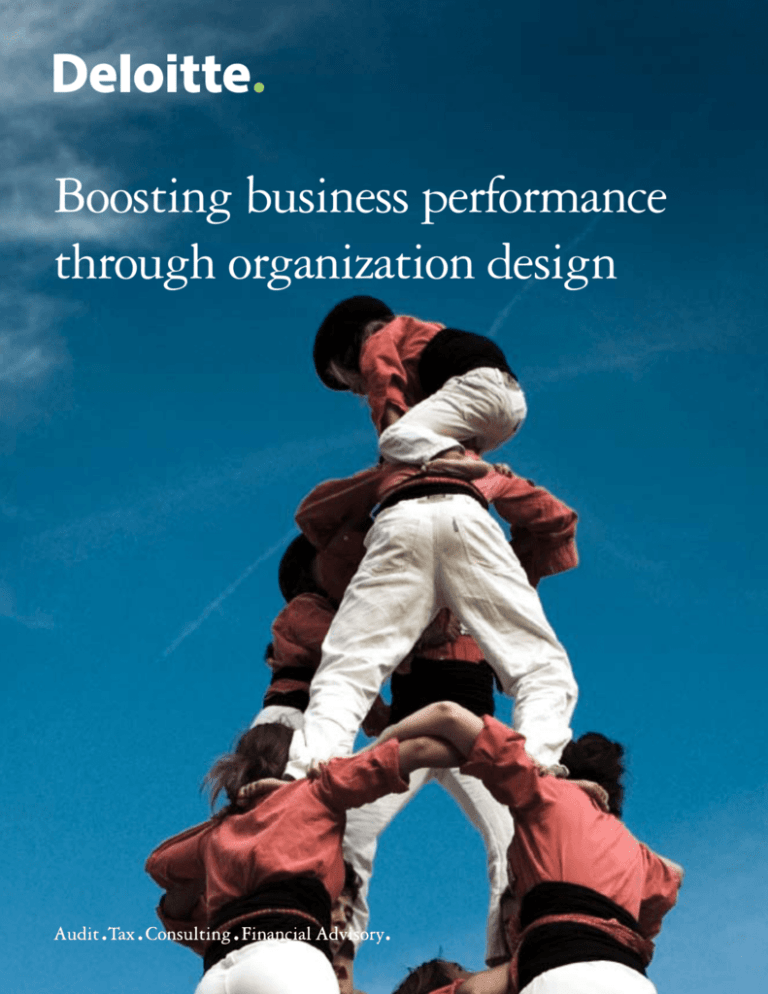
Boosting business performance
through organization design
Organizations and people: Front and center
Organization design is the vehicle through which business strategy
is executed and defines the environment in which the talent of an
enterprise is released. To that end, organization design is a critical
business activity establishing the framework by which an enterprise
serves its customers and interfaces with the market.
As a result, a thoughtful, systematic approach to designing the
organization is a key responsibility of senior executives and one of the
few levers they can directly manage to help them achieve competitive
advantage in an extremely challenging global marketplace. It is a
creative act that, when executed effectively, enables ease of doing
business, provides clarity to customers and vendors, spurs innovation,
and releases the talent of the enterprise. Conversely, a poorly executed
organization design can create barriers of entry for customers,
frustrate vendors ability to effectively partner, inhibit the release of
talent by creating unnecessary silos, and hamper value creation.
With that in mind, it is our contention that organization design
transcends the act of aligning the components of a business; instead,
it is a critical mechanism for positioning an enterprise for financial
success by making the structure itself a source of competitive
advantage. Through our work with global companies, we have
developed a simple, clear, yet powerful approach to organization
design that can be applied by business leaders at every level. Most
importantly, we believe it can help companies achieve the competitive
advantage they want.
Most global companies are well down the path of articulating
global product and customer strategies and optimizing their
processes through Web-enabled technologies. The next frontier is
maximizing the effectiveness of their organization’s design and the
talent within them.
Jeff Schwartz, global leader of Deloitte Consulting’s Organization
and Change service line
When to design:
Most organizations today, both public and private, are facing
unprecedented internal and external pressures for a number
of external and internal reasons that are creating the need for
improved organizational design.
External triggers:
• Changes in the competitive environment in domestic or
international markets
• Demands from customers or suppliers
• Pressure to reduce costs or improve performance
• Regulatory environment changes
• The quest for innovation
Internal triggers:
• The business is starting up a new company, division, or
product line
• The business is planning to grow (number of transactions or
geography)
• The business strategy and/or leadership has changed
• The organization around the business has changed as a result of
a merger, acquisition, or divestiture
• The business isn’t delivering the performance expected
Organization design 101: The elements of organization
For many, organization design conjures up an image of managers
tinkering with “sticks and boxes” on the back of a napkin.
Organization design can and should be much more than what it too
often is: a haphazard mix of art and science using structural elements
that are based as much on politics as business value. The result of that
haphazard blend can be organization design that is too “siloed” to
allow companies to pursue operational excellence, too fragmented to
encourage the collaboration required for innovation, or too distracted
or unwieldy to support a focus on the real customer.
As we see it, organization design is about helping the business achieve
its goals and objectives and deliver value. It consists of the structural
elements that drive business strategy and bring the strategy “to life,”
reflected in people’s behavior. Organization design should be built
on the principle that an effective organization consists of interrelated
groups that are structured to interact with one another in ways that
get work done. An organization can be a whole corporation or one
part of it. It can have tens of thousands of people or just a
few dozen.
Figure 1: Deloitte’s Organization Assessment Framework
V isio n & M issio n
V a lu e s
S tra te g y
Structure
Leadership
External
Environment
Trends
Capabilities
Culture
Industry
Regulatory
Community
Political
Technology
advances
People/
Talent
Decisions
Technology
Market
Forces
Globalization
Competitors
Customers
Financial
Markets
Labor
Markets
Suppliers
Processes &
Policies
Performance Excellence
External Indicators
Shareholder Value
Profitability
ROI
Market Share
Customer
Satisfaction...
Internal Indicators
Realization of
Performance Metrics
Employee
Engagement
Productivity
Costs...
As used in this document, “Deloitte” means Deloitte Consulting LLP, a subsidiary of Deloitte LLP. Please see www.deloitte.com/us/about for a detailed description of the legal structure of
Deloitte LLP and its subsidiaries.
We have found that an organization acts as a complex, open
system, which has a number of interrelated elements and the
specific characteristics of each company will determine the scope of
organization design.
One accelerator that can help executives better understand the
interrelation of organizational elements is the Deloitte Organization
Assessment Framework (please see Figure 1). The model provides a
frame of reference to help identify and diagnose the effectiveness
of the key drivers of an organization’s performance. The framework
highlights the existing links between those key drivers (structure,
process and policies, technology, etc.) and their alignment with an
organization’s strategy. That level of alignment, in turn, is associated
with an organization’s ability to deliver against its strategic goals. All
the while, external environment trends and market forces influence
and reshape the corporate strategy forcing a re-evaluation of the key
drivers.
Conducting an organization assessment includes collecting data,
identifying root causes, and defining solutions. These solutions may
involve one or many of the key organization performance drivers.
For example, a solution could be standalone change in organization
structure or, more typically, structural changes enabled by subsequent
changes in business processes, skills, decision rights, or performance
measures . Using the Deloitte Organization Assessment Framework
facilitates a consistent and holistic approach to organization
assessment which should lead to a better understanding of the
company, its strategy, and how key components of the organization
align with one another and contribute to the achievement of business
performance objectives.
Creating competitive advantage
When a company does an effective job of configuring these elements
through organization design, it becomes an extremely powerful
management tool that can help create a strategic competitive
advantage. Aligning organization design with business strategy can
yield efficiencies and boost company performance. Establishing the
right structure can improve an organization’s ability to meet customer
needs and create shareholder value. Specifically, effective organization
design can help a company do the following:
• Facilitate business strategy. Companies that align their
organization design with their business strategy are positioned
to do a much better job of improving their performance and
achieving their goals. This goes beyond “form following function.”
An effective organization design not only provides a vehicle for
delivering on strategy, but also creates a new working environment,
opening up new opportunities, and creating new strategic
possibilities.
• Drive value. Effective Organization design can help a company
increase value, whilst poor design can destroy value. Some of the
“soft benefits” of effective design include improved reputation,
branding, quality, and customer and employee satisfaction. Some
of the harder benefits include speedier decision making, improved
organizational metrics, increased employee productivity, and
profitability.
• Improve organizational performance. When companies seek
to improve performance – by cutting costs, improving efficiency,
targeting more lucrative customers, etc. – they often fail to analyze
the way they are organized. Effective organization design can help
a company improve performance by removing unnecessary layers
from a company’s structure and by providing managers who must
make key decisions with the necessary power and resources to do
so. Effective organization design can also help a company be more
nimble and adaptable, so it can respond to a rapidly changing
marketplace.
• Raise the effectiveness of the workforce. Organization design
can help companies redesign jobs and build new career paths,
creating an environment where employees can thrive and innovate.
Having a workforce that is more motivated and creative should not
only help a company compete for talent, but should also help it
create more value as it competes in the global marketplace.
• Facilitate business transformation. Organization design can
be a catalyst to business transformation by reinforcing a change
in strategic priorities or goals through a structural realignment. It
should grab the attention of employees and investors alike.
Meeting a 21st century challenge –
designing for talent
Organization design can also help corporations meet one of the
most important challenges of the 21st century: a looming talent
gap, which has already begun to take its toll.
The demographics are sobering. The huge baby-boom generation,
80 million people born between 1946 and 1964, has provided
U.S. corporations with one of the largest, most prolific cohorts
of talent in history. Its successor, Generation X, born between
1965 and 1981, is much smaller, about 40 million strong. These
numbers mean that, within the next decade, corporations
will have to find ways to achieve their goals with many fewer
people.1,2
In 2008, the first members of the baby-boom generation will turn
62, the average retirement age in the large, developed economies
of North America, Europe, and Asia. This means that corporations
will have to find ways to achieve their goals with many fewer
people.
By creating leaner organizations that do a better job of putting
employees in jobs for which they are best suited, organizational
design can help companies close that gap.
1 Leah Reynolds, Elizabeth Campbell Bush and Ryan Geist, “The Gen Y Imperative,”
Communication World, March-April 2008: 19-22.
2 Neil Howe, William Strauss, and R.J. Matson, Millenials Rising: The Next Generation
(New York: Vintage Books, 2000), 14-15.
Good companies, ineffective organization design
While organization design can be a powerful tool, it is trickier and
a lot more challenging than simply making a few management
changes. Most companies can sense when their organization design
is not working, but many are unsure how to tackle the problem. The
job becomes more difficult because a comprehensive organization
redesign can seem too complex and intimidating, since it is fraught
with economic and political challenges.
• Picking the wrong people. At its most basic, organization design
is about putting the right people in the right positions. In doing
organization design, companies sometimes neglect to make sure
that people chosen for leadership roles have the right combination
of knowledge, experience, and competence for the job. In particular,
they sometime fail to motivate people who can help the employees
they lead become better at their jobs.
So when executives are faced with an organization design issue, they
often take the path of least resistance – changing some leadership
roles here or redefining some jobs there. However, to be effective,
organization design must be complete. When it’s not, our experience
has shown that companies can get in trouble in several ways.
• Failing to execute. Many companies start with a strong design,
but fail to execute it. In particular, company officials pursuing
organization design may fail to secure buy-in from key leaders.
At the same time, they may fail to communicate effectively to
employees (or sometimes may not communicate at all) why
organization design is important and what goals it is meant to
achieve. Finally, over time, the enthusiasm the company’s leaders
have for organization design may fade and the old ways of doing
business return.
• Overlooking political realities. Every organization design must
have a balance between what is good for a company in the
abstract and what is possible, given who will maintain key power
relationships. Powerful individuals can make or break the execution
of the organization design depending on whether they buy into it.
• Making the wrong choices. Without a general view and an
understanding of the fundamentals of organization design,
companies often create a mismatch between the new capabilities
they want and the new structure they create. An elegant new
organization chart may not put company resources where they are
most needed.
A new approach
One of our organization design tenets is that there is no “one best
way” to structure organizations. Organizations at different stages of
their life cycles will require different structural models, and factors
such as market conditions, culture, available resources, and location
will influence a company’s choice.
At the same time, we have found that breaking the organization
design process into steps gives companies a framework within which
informed design decisions can be made. Some of the steps may occur
concurrently or in an order different than the one presented here.
Nonetheless, breaking down organization design into these steps
should help companies find a broad, end-to-end solution. The Deloitte
Global Organization Design Methodology is a four-step approach
(See Figure 2).
• Step 1: Define strategic objectives and assess current
organization. Before diving headfirst into organization design, the
organization design team must articulate the drivers for change and
define the strategic objectives to which the organization must be
aligned. The team should develop a comprehensive understanding
of how the organization currently operates, including determining
what works well and what could be improved. Getting stakeholders
to agree on design principles early on will help guide the design
and evaluation of draft models. A business case will help justify
key design decisions and will help “sell” the changes later in the
transition phase.
• Step 2: Define future core capabilities and build an operating
model. The organization design team’s next objective is to develop
hypotheses on potential organization options. The team should
define the future core capabilities required in the new organization
to deliver on the business strategy, grouping capabilities into effective
operating blocks. Core capabilities will be further developed by
considering business rules, defining key performance indicators
(KPIs), and developing a balanced scorecard that supports business
strategy. A critical activity is developing an operating model. This is
a pictorial representation of how the organization will interact with
the marketplace and how key groups and functions will interact
internally. The operating model serves as the lynchpin between
design principles, functionality, and capability to the reporting
relationships. Please see Figure 3 for an operating model example.
In this example, the operating model is designed to demonstrate a
shift from an existing country management structure to a regional
management structure supported by governance teams.
Figure 2: Deloitte global organization design methodology
Define Strategic
Objectives and Assess
Current Organization
•
•
•
•
Develop Organization Design Project Scope and Deliverables
Articulate Strategic Drivers and Design Principles
Conduct Organization Diagnostics and Roadmap
Define Improvement Opportunities and Business Case
2
Define Future Core
Capabilities and Build
Operating Model
•
•
•
•
•
Develop Organization Design Hypotheses
Define Future Core Capabilities
Align/Define KPIs and Balanced Scorecard
Develop Operating Model
In this example, the operating model is designed to demonstrate
a shift from an existing country management structure to a
regional management structure supported by governance teams
3
Design Organization
1
• Develop High-Level Organization Structure, Roles, Business Processes,
Decision Making Framework, and Transition Strategy
• Define Rewards Strategy and Leadership Profiles
• Align Business Process, Workflow, Governance, and Decision Right
4
Transition and
Evolve Organization
•
•
•
•
Transition Workforce and Execute Training Plans
Implement Business Impacts Plan
Conduct Selection Process
Evolve Organization
• Step 3: Design organization. The design team should now be
poised to design the top two to four (as appropriate) levels of
the organization based on the new operating model. Developing
conceptual organizational designs should be a highly interactive
process, often involving development of alternative structures that
are evaluated against design principles and the operating model.
The business process, workflows, and decision rights should be
aligned with this high-level organization design. Please see Figure
4 for a high-level organization design example. At a high level,
rewards principles and leadership profiles should be developed
that reinforce the new operating model. With a conceptual design
in place, the organization design team is ready to drill down into
the details. Job profiles, a business impact assessment, and an
organization transition strategy should all be developed to move
conceptual design into executable strategy.
• Step 4: Transition and evolve organization. Implementing the
design can be as big a challenge as creating it. The organization
design team should provide a step-by-step plan for making the
transition between current and future organization models. The
team can advise HR on conducting the selection process, bringing
on board and redeploying selected employees, executing a training
plan, and outplacing separated employees. The team should also
assess the impact of the transition on the organization, continuously
monitoring how well the company is achieving the business
goals of the new organization, and identifying opportunities for
improvement.
Figure 3: Operating Model Example: Facilities Services Organization
Clients
Services
Facilities
Design
Security
Cleaning
Office
Support
Poverty
Services
Country
Sales
Countries
Market
Development
Operations
Regions
Global
Strategy &
Business
Development
Human
Resources
Regional
Sales*
Latin America
North America
Central Europe
Eastern Europe
Nordic
Asia
Finance &
IT
Corporate
Sales*
Legal
Legend:
*Client Facing
Figure 4: High-Level Organization Design Example: Facilities Services Organization
Global Organization Structure
Global CEO
Regional
COOs
Sales
Finance &
IT
Strategy
HR
Legal
Regional Management Organization (one region)
Regional COO
Regional Finance Director
Regional Strategy &
Planning Director
Financial Reporting
M&A Integration
Key Account Management
Treasury Management
Business Planning
Service Management
Financial Analysis
Business Development
IT
Procurement
Management Reporting
Regional Sales Director
Regional Marketing Manager
HR
Working with an architect
Effective organization design strikes a delicate balance between the
ideal and the practical. To boost performance, organizations must
take a comprehensive approach, one that starts with an honest
look in the mirror and considers what will be most effective for the
company. Then they have to make difficult changes. At the same
time, organizations must keep key people engaged so they can
retain essential talent through the transition. In a sense, organization
design is similar to constructing a building: both require an architect
responsible for structural soundness and managers responsible for
execution according to plan.
An organization design architect can help a company make the tough
choices that a change requires. The most effective architects not only
have organization design experience, they also thoroughly understand
the business and the industry they are working with. They act as
guides through the change management process, working with key
people inside the organization to make important decisions. Often,
organization design architects work with an advisory committee to
help them make certain organization design decisions.
Overall, the architect can provide design parameters, develop the
conceptual operating model, and help lead the organization through
the steps outlined above.
Organizational design for growth
Case Example – Motorsports manufacturer
A motorsports product manufacturer with revenues of $3 billion
annually wanted to grow. The subsidiary of a Japanese parent
firm, the company had a three-year plan that called for 70-percent
growth in a flat market.
To help the company meet its objectives, Deloitte helped them
create an organization design that aligned the company’s structure
with its goal of becoming more customer-centric and executing
an area marketing strategy. To facilitate this undertaking, Deloitte
helped the company:
• Synthesize project information and the company’s goals
• Analyze current and future states
• Create vision statement for the organization design
• Design the future organization structure
• Design jobs and develop competency profiles
• Develop an implementation plan
Under the new organization design, the role of the field sales
representative was changed to emphasize a consultative, hightouch approach. Field sales representatives were expected to
provide more hands-on assistance to dealers, helping identify
ways for the dealer to increase sales, connect with customers,
and improve profitability. To execute this plan, Deloitte helped the
client develop a staffing model that called for an increase in the
number of field sales representatives. As the company executed
this plan, field sales representatives were able to decrease their
territory size, freeing them up to increase dealer interaction. But
providing a high-touch approach also required the field sales
representative to have greater skills and a different combination
of competencies. After assessing the competencies of legacy
field sales representatives and comparing them to the ideal
competencies identified in the go-forward job profile, Deloitte
helped the client develop a training program aimed at bridging the
major competency gaps. Finally, Deloitte helped the client revise
the sales incentive plan of the affected workers to account for the
new territory size and align desired behaviors and competency
development goals with monetary rewards.
In the end, the company executed a pilot program design to
reduce risk. A lot of responsibility was pushed to the field and, as
a result, business results for high touch pilot areas outperformed
sales in non-high touch areas by 5%-10%. On the heels of these
results, the company recently announced a major investment in
expanding its sales, service, and accessories staff throughout the
organization.
Design for competitive advantage
Customer-centric organization design
To use organization design to generate competitive advantage,
executives should think holistically about the elements of business
strategy and leadership, organization and job design, and decision
rights. They can start by asking:
• How is my organization structure affecting the value and results of
my business?
• Does my organizational design allow the achievement of strategic
goals and objectives?
• To what extent are customer-centric drivers incorporated into the
organization design?
• Are roles and responsibilities well defined and understood?
• Are common capabilities and processes grouped together to deliver
an efficient execution?
• Are decision-making processes well defined, clearly understood, and
most important, are they followed?
• What actions do I need to take to help facilitate achieving the goals
and objectives of the organization?
• What role must I play in enabling this to happen?
Case Example – Health care manufacturer
A global manufacturer of health care products and related services
was looking to achieve its global supply chain vision of enabling
consistent customer experiences, improving price and product
availability information, and providing a unified view of the
customer. One of the organization’s product segments had a plan
to establish common processes and core systems across the North
American business units.
Armed with the answers to those questions, executives can use
organization design to help align the work employees do with
the goals of the organization. That will give the organization the
capabilities it needs to achieve competitive advantage in a global
marketplace that is rapidly changing and extremely challenging.
The decentralized structure limited the organization’s ability to
serve the customer effectively and conduct business efficiently.
Additionally, the barriers of conducting day-to-day operations
were exacerbated by the number of legacy systems used and the
complexity of the processes involved.
As part of their North American Supply Chain vision, Deloitte
provided consulting services to the organization in support of their
efforts to:
• Define the value proposition and strategy for the customer
contact centers
• Assess the current state of the organization and define future
business and customer requirements and needs
• Design the future state operating model and detailed
organization of the centralized functions:
– Consolidated customer contact centers
– Accounts receivable
– Warehouse management
– Transportation management
– Master data management
• Develop job profiles, performance metrics, career paths, staffing
model, and competency model
• Identify and analyze organizational and business impacts across
multiple locations
• Develop an integrated training program
• Develop strategic communications and implementation
playbook
• Design a regional decision-making governance model
To understand the customer-centric view of this organization,
Deloitte practitioners worked closely with business and HR
representatives throughout the organization design process,
interacted with customers to gather Voice of the Customer data,
interviewed and shadowed customer service representatives, and
conducted interactive workshops to help the client in their efforts
to validate design options and gain leadership alignment.
The transformational organization design integrated the customer,
people, process, policies, and technology aspects of the business
in order to position the organization to achieve its vision. The
organization has since successfully implemented the redesigned
accounts receivable, warehouse management, transportation
management, and master data management functions. The
consolidated customer contact centers are being rolled out in
a phased approach to facilitate a smooth transition designed
to minimize customer impact. This strategic transformation has
already made it easier for customers to do business with this
organization.
Self Check – Is Your Organization Design Delivering Value?
To check, please take a moment to answer the following questions. At the end, you’ll be able to rate your responses to yield an overall score.
To what extent do you agree or disagree with the following:
Strategy and
Leadership
• The organizational design allows the achievement of strategic goals and
objectives
• Executive leadership roles, responsibilities, and decision-making
accountabilities are well defined and support the mission and goals
• Resource needs are periodically evaluated to allow effective long-term
resource planning
Organization and
Job Design
• Roles and responsibilities are well defined and understood
• The right talent with the appropriate skills are appointed into key positions
• Common capabilities and processes are grouped together effectively
• Self-service, shared services, offshoring, or outsourcing are leveraged for
commodity-like activities
• Clearly defined career paths, staff development, and succession planning
processes are established
Decision Rights
• Decision-making processes are well defined, clearly understood, and
followed
• Decision-making groups are operating as per their defined roles and
responsibilities
• Decisions are based on fact-based analysis and are executed on a timely
basis
• Decisions are consistently communicated across the organization
Fully
Agree
Partially
Agree
Disagree
To rate your responses, please use the following scores for each response:
• Fully Agree = 2 points
• Partially Agree = 1 point
• Disagree = 0 points
Add up your total points to yield an overall score.
• If your score was 16-24: Your organization design is delivering
value. There may still be some pockets for improvement, but
you are well on your way to boosting performance and driving
change through organization design. For targeted improvements,
carefully examine the questions that you answered with “Disagree”
or “Partially Agree” and look for ways to make improvements.
You may consider soliciting help from HR representatives or an
experienced organization design architect.
• If your score was 8-16: Your organization design is delivering value
in some areas, but not in others. More could be done to leverage
the use of organization design in your company. For the questions
that you answered with “Disagree” or “Partially Agree”, identify
those areas that either have the largest negative impact on your
organization or that can be easily remedied. Consider bringing these
issues up at an upcoming business meeting where strategy and
organization design can be a topic of discussion. Consider charging
individuals or an ad hoc committee with the task of developing
recommendations of ways to make improvements to the identified
focus areas, bringing in appropriate expertise where necessary.
10
• If your score was 0-8: Your organization design is not delivering
value in most areas. If your company does not improve its
organization design capabilities, it may very well lose ground
on your competitors. Consider forming an organization design
team to take a broad look at the organization, define strategic
objectives, and assess the current organization. The team should
get key stakeholders involved in the process to define objectives of
an improved organization design. Consider collaborating with an
organization design architect to help create competitive advantage
through organization design. Execute an organization design
improvement project utilizing the approach outlined in this paper.
For more information, please contact one of the following Organization and Change contacts
Jeff L. Schwartz
Principal
Global and U.S. Practice Leader
Deloitte Consulting LLP
jeffschwartz@deloitte.com
+1 703 251 1501
David Hole
Senior Manager
U.S. Decision Rights Service Lead
Deloitte Consulting LLP
dahole@deloitte.com
+1 212 618 4067
Jennifer Radin
Principal
U.S. Practice leader for Organization Strategies
Deloitte Consulting LLP
jradin@deloitte.com
+1 212 618 4833
Blair Carlson
Manager
Organization Design Specialist
Deloitte Consulting LLP
bcarlson@deloitte.com
+1 310 903 9430
Bhushan Sethi
Senior Manager
U.S. Organization Design Competency Lead
Deloitte Consulting LLP
bsethi@deloitte.com
+1 212 313 1655
www.deloitte.com
11
This publication contains general information only and is based on the experiences and research
of Deloitte practitioners. Deloitte is not, by means of this publication, rendering business, financial,
investment, or other professional advice or services. This publication is not a substitute for such
professional advice or services, nor should it be used as a basis for any decision or action that
may affect your business. Before making any decision or taking any action that may affect your
business, you should consult a qualified professional advisor. Deloitte, its affiliates, and related
entities shall not be responsible for any loss sustained by any person who relies on this publication.
Copyright © 2008 Deloitte Development LLC. All rights reserved.

